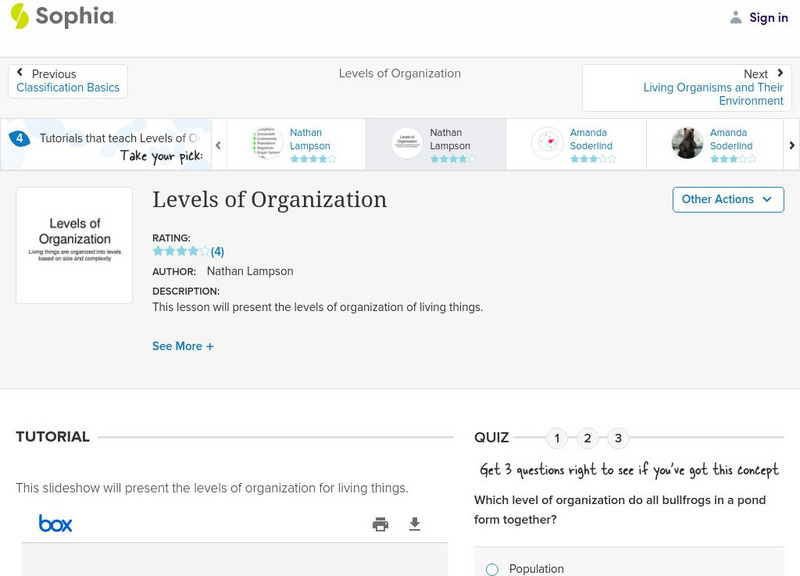Curated OER
"Virtual" Model United Nations Day
Students identify and analyze that Global Interdependence and Internationalism have become major themes in human activity in the areas of population, environment, the world economy, and the United Nations.
Students identify the...
Curated OER
DNA and Individual Differences
Students list differences between DNA-related terms and create a simple DNA circle map. They order terms including human body, organ, tissue, cell, nucleus, etc. from largest to smallest. They discuss differences and similarities among...
Curated OER
The Internal Anatomy of the Grasshopper
Sixth graders explore the internal organs of grasshoppers. They determine the function of the organs through a dissection activity.
Curated OER
What Becomes of Cell?
Sixth graders analyze and compare a cell's tissues, organs and organ systems. They watch a video reviewing the body systems and design poster boards showing their functions.
Curated OER
I, Me, Myself
Students create a big book self portrait of the human body. Inside, students illustrate pictures of the major organs, label, and paste them inside the big book.
Curated OER
What is an Organism?
Sixth graders take a pre-test and summarize teacher's discussion of cells, tissues, organs in their notebooks. They read selections on organisms in their textbook and perform a dissection of a chicken drumstick with the thigh attached....
Curated OER
Cell Cookies
Fifth graders, in groups, create a plant or animal cell out of cookies, frosting, and candy pieces.
Curated OER
The Making of an Organ
Students examine and research how cells make up our organs. They create a model of a tongue showing cells, tissues and the organ.
Curated OER
I Need Air
Students examine and research the organs of the respiratory system. They participate in a vocabulary card matching game, create a graphic organizer, and participate in an experiment titled, Floating on Air.
Curated OER
The Human Body Systems - Lesson Plan
Students identify the following organ systems in the human body and state their functions: muscular, skeletal, circulatory, respiratory, digestive.
Curated OER
What's on Your Plate?
Pupils demonstrate the path of food in the body. In this biology lesson, students conduct an experiment to determine how large the the digestive system is. They name the different organs involved in the digestive process.
Curated OER
The Human Organism
Seventh graders examine the basic functions of the human body and see how changing demands affect our bodies. In this human organism lesson students participate in several activities that are about the human body and our digestion,...
Curated OER
Jenny's Science Wordsearch
In this biology activity, learners identify and locate various vocabulary terms related to the science of biology and anatomy. There are 10 biology terms located in the word search.
Curated OER
Mozart
In this music activity, learners read a brief excerpt about Mozart's music and life. They respond to 11 questions in complete sentences related to the excerpt on Mozart.
Curated OER
Body Organization
Seventh graders explore how the body is organized. They create flashcards of key terms and visit stations to view levels of organization in the human body. They examine themselves and rearrange their flashcards in order of increasing...
Curated OER
It's Time to Get Organ-Wised
Students engage in a lesson which contains several ideas for a unit on the body and body organs. They solve riddles, color in shapes of organs, participate in games and read about the functions of the various organs. Worksheets are...
Curated OER
Laparoscopy Tissue Biopsy
Students describe the anatomy and physiology of a selected organ. They identify the major artery and vein that delivers blood to and from the selected organ and construct an accurate scaled 3D model of a selected organ.
Curated OER
Kirk Medical School
Fifth graders conduct research on the major organ systems of the human body. They create and present 3D models of a body system, and collect basic first-aid supplies for donation to a third-world community.
Georgia Department of Education
Ga Virtual Learning: Ap Biology: Animals
This unit focuses on the unique structure and function of both invertebrate and vertebrate animals. Students review their understanding of animal diversity, and take a closer look at the various organ systems found in the animal kingdom.
Texas Education Agency
Texas Gateway: Animal System Interactions
Review over the body systems of the organisms in this tutorial.
OpenStax
Open Stax: Exercise, Nutrition, Hormones, and Bone Tissue
All of the organ systems of your body are interdependent, and the skeletal system is no exception. The food you take in via your digestive system and the hormones secreted by your endocrine system affect your bones. Even using your...
Scholastic
Scholastic: Study Jams! Science: The Human Body
Self-playing slideshow, with an accompanying quiz, introduces students to the concept of the human body as a system of cells, tissues, and organs.
Sophia Learning
Sophia: Levels of Organization: Lesson 4
This lesson will present the levels of organization of living things. It is 4 of 6 in the series titled "Levels of Organization."
CPALMS
Florida State University Cpalms: Florida Students: Levels of Organization
FSERL: Explanation of the hierarchical levels of living things.

























